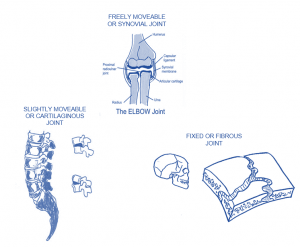Classification of joints
Wherever two or more bones meet, a joint or articulation exists.
Movement does not always occur at these joints, and the amount of movement allowed at each determines its classification:
- Fibrous or fixed joints: fibrous joints occur where bones are joined by intervening fibrous tissue. These are very stable joints and do not allow any observable movement. Tough fibrous tissue lies between the ends of the bone, which are dovetailed. These strong fibres are called sutures. Examples include the sutures of the cranium and pelvis.
- Cartilaginous or slightly movable joints: the ends of bones, which are covered in hyaline cartilage, are separated by pads of tough, fibrous cartilage (white fibro-cartilage), which provide stability and possess shock absorbing qualities. A small amount of movement usually exists in these joints because the pads of cartilage compress. Examples include the intervertebral discs of cartilage between the lumbar vertebrae.
- Synovial or freely movable joints: these are most common type of joint in the body and the most important for physical activity, as it is these joints that allow a wide range of movements. A synovial joint is characterised by the presence of a joint capsule and cavity. This type of joint is subdivided according to movement possibilities, which are determined by the bony surfaces that actually form the joint.

